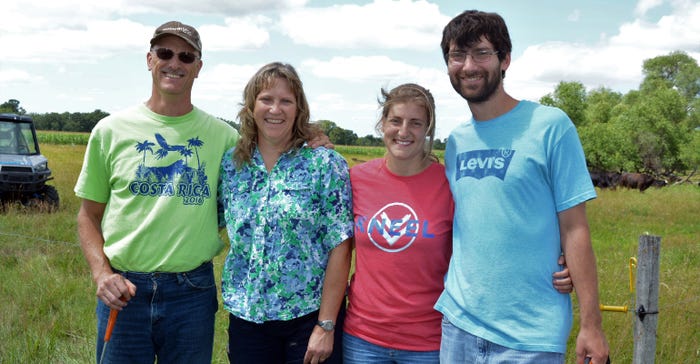
With dual goals of healthy soil and low-cost beef production, the Miller and Tabert families operating Trinity Creek Ranch near Red Lake Falls, Minn., are continually experimenting with crops and covers to learn what fits best with their environment and management.
“We’re farming for net profit, not yield,” says Mikayla Tabert. Her family’s farm, located on the edge of the Red River Valley, was started by her grandparents in 1952 and now includes her husband, Ben, and her parents, David and Peggy Miller. They manage a small feedlot and have 150 cow-calf pairs of Angus, Hereford and Gelbvieh, and oversee a diverse crop rotation of corn, soybeans, wheat, peaola (an intercrop of field peas and canola), alfalfa, turfgrass, cereal rye and sunflowers. They also sell forage and cover crop seed.
Crop practices focused on soil issues began in the early 1990s with David using no-till and strip-till planting to reduce erosion and increase soil organic matter. Since then, they’ve followed up by experimenting with various cover crop mixes and spreading seed with a fertilizer spreader, flying it on and interseeding.
Mikayla notes that rotating crops and cattle keep them all busy, yet the diversification helps their business be more resilient.
“You know what crop commodity prices can be like, or you get a wet year, dry year, certain crops do better than others,” she says. “We like having a diverse mix so that we can have a fail-safe. And if all else fails, we always have the cattle.”
After experimenting with cover crops for a few years, the Millers and Taberts decided to participate in the Soil Health Partnership, a farmer-led initiative of the National Corn Growers Association involving more than 200 farmer-members mainly in the greater Midwest. They continue to learn about cover crops through their own experimenting and by networking with other like-minded farmers. Building organic matter and reducing purchased inputs continue to be key goals. Specific to cover crops, they have learned they need a complete plan — at least on paper — to guide their decision-making.
“We’re trying to figure out crop rotations — six, eight, 10 years — and what residues are available for weed control,” Mikayla says. Of course, weather has the final say with anything pertaining to crops. On their 1,200-acre farm, each crop in rotation is around 120 to 150 acres. Soils range from light to heavy clay.
They interseeded corn for the first time in 2018. In 2020, they got set up to apply a 28% UAN sidedress at the same time, and continue to fine-tune that practice. They like to interseed at V4. They will also continue to try interseeding 60-inch corn this season to increase cover crop growth for winter grazing.
The last two growing seasons, they interseeded a cover crop into sunflowers. The first year, they seeded the sunflowers and cover crop at the same time. But the cover crop may have been too competitive with the sunflowers and seemed to impact yield. Then last year, they waited too long to interseed. The sunflowers were too tall and impeded cover crop growth. They’ll give this effort another go this year.
Year-round grazing
Rotational grazing of cattle, especially in winter, helps keep feed costs low — around $1 per cow per day. And yes, they graze in winter. This winter season, cattle are grazing on cornstalk residue and cover crops (the latter seeded after harvest and some grown for the full season), and tall fescue regrowth. Lying under the snow is hay cut for swath grazing, plus baled hay is set out for when it is needed, too.
The farm has around 40 paddocks, ranging from 3 to 10 acres in size. Tanks are supplied with water via an underground pipeline. In winter, cattle are moved every two to three days to a fresh site. During the growing season, they are moved every day, depending on pasture growth. After grazing, each paddock rests 45 to 90 days, depending on growing conditions.
“We’ve learned to let cattle graze half [the forage] and then leave half,” Mikayla says. “When more than 50% of the plant is eaten, the roots start dying more rapidly.”
Plant growth is of special interest to Mikayla, who begins a master’s degree program in plant science in May at North Dakota State University. Her focus? The effect of cover crop competition on cash crops.
An applicable area of study, hands down.
About the Author(s)
You May Also Like






